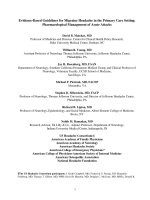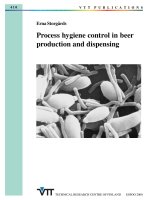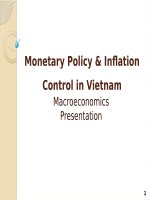AN0764 implementing temperature based variable fan speed control in NLX power supplies
Bạn đang xem bản rút gọn của tài liệu. Xem và tải ngay bản đầy đủ của tài liệu tại đây (193.8 KB, 4 trang )
M
AN764
Implementing Temperature-Based Variable Fan Speed
Control in NLX Power Supplies
Author:
1.
Microchip Technology Inc.
INTRODUCTION
The NLX Power Supply Specification released by Intel®
Corporation defines the requirements for next-generation PC system power supplies. There are several
enhancements outlined in this specification as compared to the “old” PS/2 power supply form factor. One of
these features is control and monitoring of the cooling
fan(s) inside the NLX power supply. The NLX specification designates two interface fan control signals:
1.
2.
FanM signal is an output from the NLX-compliant power supply. This signal allows the host
(typically a system management ASIC) to monitor fan RPM. FanM is an open-collector signal
consisting of two pulses per fan rotation.
FanC is an input to the NLX-compliant power
supply used by the motherboard to regulate fan
speed and to shut the fan down. FanC is a 0V to
12V analog signal.
BRUSHLESS DC FAN BASICS
Brushless DC (BDC) fans are popular for cooling electronics and come in many voltage, current and CFM
ratings. The most common versions in PCs are +5V
and +12V. The nominal voltage rating is typically the
input voltage at which the fan runs at approximately
100% RPM. Some fans have a third terminal that
outputs pulses as a tachometer signal.
2.
APPLICATION CIRCUIT
The application circuit using the Microchip TC646 is
shown in Figure 2. Please refer to the TC646 datasheet
(DS21446) for details on pin descriptions. The overall
circuit can be broken down into five basic functional
blocks, plus the TC646 itself:
1.
RPM %
100
50
PWM Drive
2.
Linear Drive
0
0
6
VFAN (Avg.) Volts
12
FIGURE 1:
Linear Voltage Control vs.
Pulse-Width Modulation.
2003 Microchip Technology Inc.
Linear Voltage Control: This method varies the
DC voltage at the VDD terminal of the fan in a linear manner. For example, a +12V nominal fan
modulated linearly to +8V would theoretically
run at 66.7% RPM. Though this seems relatively
simple, there are drawbacks. All BDC fans have
a “stall voltage” that can vary from 35% to 60%
of nominal voltage, making wide-range speed
control impossible. Additionally, there is considerable start-up hysteresis after a stall, complicating matters further. Lastly, linear speed
control is inefficient, generating excessive heat.
Pulse Width Modulation: This method applies
the full DC nominal voltage to the fan, but only
for a duty cycle that corresponds to the desired
speed. The average energy delivered to the fan
is, therefore, varied over a wide range and stall
voltage is not an issue.
3.
FanC “Y-Network” Input From Motherboard:
This section accepts the 0V–12 VDC signal
from an NLX-compliant motherboard. The Ynetwork formed by R12, R1 and R2 performs
level shifting and range compression to match
the 1.25V–2.65V analog input range of the
TC646. The FanC signal indicates a shutdown
request at or below +1 VDC. Above that, the signal is used for proportional fan speed control. If
FanC becomes disconnected or is not present,
the fan will be driven at full speed via the R13
pull-up resistor.
Thermistor-Controlled Fan Override: T1 (thermistor 10 kΩ at 25°C), R6 and Q1 form the “thermal override function”. This circuit provides a
local override in the event of high ambient
temperature. Under normal operation, Q 1 is off.
Output Stage: This section consists of the fan
and its drive components: R5, Q 2. The signal
output from the VOUT pin is a 30 Hz nominal
5 Vp-p PWM waveform. Q2 is a 2N2222A smallsignal BJT. The fan is driven to a full +12V
(minus Q2 saturation voltage).
DS00764B-page 1
AN764
4.
5.
SUMMARY
FanM Signal: To fully comply with NLX specification, the power supply must provide a signal
back to the motherboard (FanM). The NLX
specification requires this signal to be an opencollector output from the tachometer of a 3-wire
fan.
Minimum Speed and Auto-Shutdown: R3 and
R4 form a divider network that defines the shutdown threshold of the circuit. This corresponds
to the +1V NLX-specification for fan shutdown.
The Microchip TC646 Fan Speed Controller allows a
computer designer to implement a robust system-cooling design and be fully NLX-compliant. Additionally, the
PWM control mode is superior to traditional linear control methods. The low cost of the TC646, and its supporting components, make it the ideal choice for highvolume applications.
System operation is straight-forward: fan speed ranges
from approximately 30% to 100% for a FanC voltage
range of 1V to 10.5V. The fan will be held in shutdown
when FanC is less than 1V. FanM is returned to the
motherboard as prescribed in the NLX specification.
FanM also is monitored by the TC646. FAULT is
asserted if the fan fails to operate (see TC646
datasheet for details). Additionally, C 4 sets the 30 Hz
PWM frequency and R7 is the pull-up resistor for the
FAULT output.
+12V
R8
10 kΩ
+5V
FanM
(To Motherboard)
R10
Q4
2N2222A
C9
0.47 µF
Override
R11
36 kΩ
R13
10 kΩ
FanC 0V-12V
(From Motherboard)
+5V
Q1
2N2222A
R6
4.7 kΩ
C6
0.1 µF
VOUT
+
-
VIN
C2
0.01 µF
+5V
1 µF
+
C4
R3
33 kΩ
R4
16 kΩ
FIGURE 2:
DS00764B-page 2
VDD
D1
1N4148
R1
100 kΩ
C8
0.01 µF
C1
10 µF
SENSE
+5V
R12
287 kΩ
R2
52.3 kΩ
(23CFM)
F1
(DAFB0912M-FOO)
(-)
+5V
T1
NTC
10 kΩ
+12V
R9
2.7 kΩ
(TACH)
4.7 kΩ
Q3
2N3906
(+)
30 kΩ
C7
0.47-1 µF
(Optional)
+5V
TC646
CF
R7
10 kΩ
FAULT
C3
.01 µF
VAS
Q2
2N2222A
R5
System
Shutdown
Gnd
BDC fan control for NLX power supply (3-wire fan).
2003 Microchip Technology Inc.
Note the following details of the code protection feature on Microchip devices:
•
Microchip products meet the specification contained in their particular Microchip Data Sheet.
•
Microchip believes that its family of products is one of the most secure families of its kind on the market today, when used in the
intended manner and under normal conditions.
•
There are dishonest and possibly illegal methods used to breach the code protection feature. All of these methods, to our
knowledge, require using the Microchip products in a manner outside the operating specifications contained in Microchip's Data
Sheets. Most likely, the person doing so is engaged in theft of intellectual property.
•
Microchip is willing to work with the customer who is concerned about the integrity of their code.
•
Neither Microchip nor any other semiconductor manufacturer can guarantee the security of their code. Code protection does not
mean that we are guaranteeing the product as “unbreakable.”
Code protection is constantly evolving. We at Microchip are committed to continuously improving the code protection features of our
products. Attempts to break microchip’s code protection feature may be a violation of the Digital Millennium Copyright Act. If such
acts allow unauthorized access to your software or other copyrighted work, you may have a right to sue for relief under that Act.
Information contained in this publication regarding device
applications and the like is intended through suggestion only
and may be superseded by updates. It is your responsibility to
ensure that your application meets with your specifications. No
representation or warranty is given and no liability is assumed
by Microchip Technology Incorporated with respect to the
accuracy or use of such information, or infringement of patents
or other intellectual property rights arising from such use or
otherwise. Use of Microchip’s products as critical components in
life support systems is not authorized except with express
written approval by Microchip. No licenses are conveyed,
implicitly or otherwise, under any intellectual property rights.
Trademarks
The Microchip name and logo, the Microchip logo, KEELOQ,
MPLAB, PIC, PICmicro, PICSTART, PRO MATE and
PowerSmart are registered trademarks of Microchip Technology
Incorporated in the U.S.A. and other countries.
FilterLab, microID, MXDEV, MXLAB, PICMASTER, SEEVAL
and The Embedded Control Solutions Company are registered
trademarks of Microchip Technology Incorporated in the U.S.A.
Accuron, dsPIC, dsPICDEM.net, ECONOMONITOR,
FanSense, FlexROM, fuzzyLAB, In-Circuit Serial Programming,
ICSP, ICEPIC, microPort, Migratable Memory, MPASM, MPLIB,
MPLINK, MPSIM, PICC, PICkit, PICDEM, PICDEM.net,
PowerCal, PowerInfo, PowerTool, rfPIC, Select Mode,
SmartSensor, SmartShunt, SmartTel and Total Endurance are
trademarks of Microchip Technology Incorporated in the U.S.A.
and other countries.
Serialized Quick Turn Programming (SQTP) is a service mark of
Microchip Technology Incorporated in the U.S.A.
All other trademarks mentioned herein are property of their
respective companies.
© 2003, Microchip Technology Incorporated, Printed in the
U.S.A., All Rights Reserved.
Printed on recycled paper.
Microchip received QS-9000 quality system
certification for its worldwide headquarters,
design and wafer fabrication facilities in
Chandler and Tempe, Arizona in July 1999
and Mountain View, California in March 2002.
The Company’s quality system processes and
procedures are QS-9000 compliant for its
PICmicro ® 8-bit MCUs, KEELOQ® code hopping
devices, Serial EEPROMs, microperipherals,
non-volatile memory and analog products. In
addition, Microchip’s quality system for the
design and manufacture of development
systems is ISO 9001 certified.
2003 Microchip Technology Inc.
DS00764B - page 3
M
WORLDWIDE SALES AND SERVICE
AMERICAS
ASIA/PACIFIC
Corporate Office
Australia
2355 West Chandler Blvd.
Chandler, AZ 85224-6199
Tel: 480-792-7200 Fax: 480-792-7277
Technical Support: 480-792-7627
Web Address:
Microchip Technology Australia Pty Ltd
Suite 22, 41 Rawson Street
Epping 2121, NSW
Australia
Tel: 61-2-9868-6733 Fax: 61-2-9868-6755
Rocky Mountain
China - Beijing
2355 West Chandler Blvd.
Chandler, AZ 85224-6199
Tel: 480-792-7966 Fax: 480-792-4338
Atlanta
3780 Mansell Road, Suite 130
Alpharetta, GA 30022
Tel: 770-640-0034 Fax: 770-640-0307
Boston
2 Lan Drive, Suite 120
Westford, MA 01886
Tel: 978-692-3848 Fax: 978-692-3821
Chicago
333 Pierce Road, Suite 180
Itasca, IL 60143
Tel: 630-285-0071 Fax: 630-285-0075
Dallas
4570 Westgrove Drive, Suite 160
Addison, TX 75001
Tel: 972-818-7423 Fax: 972-818-2924
Detroit
Tri-Atria Office Building
32255 Northwestern Highway, Suite 190
Farmington Hills, MI 48334
Tel: 248-538-2250 Fax: 248-538-2260
Kokomo
2767 S. Albright Road
Kokomo, Indiana 46902
Tel: 765-864-8360 Fax: 765-864-8387
Los Angeles
18201 Von Karman, Suite 1090
Irvine, CA 92612
Tel: 949-263-1888 Fax: 949-263-1338
San Jose
Microchip Technology Inc.
2107 North First Street, Suite 590
San Jose, CA 95131
Tel: 408-436-7950 Fax: 408-436-7955
Toronto
6285 Northam Drive, Suite 108
Mississauga, Ontario L4V 1X5, Canada
Tel: 905-673-0699 Fax: 905-673-6509
Microchip Technology Consulting (Shanghai)
Co., Ltd., Beijing Liaison Office
Unit 915
Bei Hai Wan Tai Bldg.
No. 6 Chaoyangmen Beidajie
Beijing, 100027, No. China
Tel: 86-10-85282100 Fax: 86-10-85282104
China - Chengdu
Microchip Technology Consulting (Shanghai)
Co., Ltd., Chengdu Liaison Office
Rm. 2401-2402, 24th Floor,
Ming Xing Financial Tower
No. 88 TIDU Street
Chengdu 610016, China
Tel: 86-28-86766200 Fax: 86-28-86766599
China - Fuzhou
Microchip Technology Consulting (Shanghai)
Co., Ltd., Fuzhou Liaison Office
Unit 28F, World Trade Plaza
No. 71 Wusi Road
Fuzhou 350001, China
Tel: 86-591-7503506 Fax: 86-591-7503521
China - Hong Kong SAR
Microchip Technology Hongkong Ltd.
Unit 901-6, Tower 2, Metroplaza
223 Hing Fong Road
Kwai Fong, N.T., Hong Kong
Tel: 852-2401-1200 Fax: 852-2401-3431
China - Shanghai
Microchip Technology Consulting (Shanghai)
Co., Ltd.
Room 701, Bldg. B
Far East International Plaza
No. 317 Xian Xia Road
Shanghai, 200051
Tel: 86-21-6275-5700 Fax: 86-21-6275-5060
China - Shenzhen
Microchip Technology Consulting (Shanghai)
Co., Ltd., Shenzhen Liaison Office
Rm. 1812, 18/F, Building A, United Plaza
No. 5022 Binhe Road, Futian District
Shenzhen 518033, China
Tel: 86-755-82901380 Fax: 86-755-82966626
China - Qingdao
Rm. B503, Fullhope Plaza,
No. 12 Hong Kong Central Rd.
Qingdao 266071, China
Tel: 86-532-5027355 Fax: 86-532-5027205
India
Microchip Technology Inc.
India Liaison Office
Divyasree Chambers
1 Floor, Wing A (A3/A4)
No. 11, O’Shaugnessey Road
Bangalore, 560 025, India
Tel: 91-80-2290061 Fax: 91-80-2290062
Japan
Microchip Technology Japan K.K.
Benex S-1 6F
3-18-20, Shinyokohama
Kohoku-Ku, Yokohama-shi
Kanagawa, 222-0033, Japan
Tel: 81-45-471- 6166 Fax: 81-45-471-6122
Korea
Microchip Technology Korea
168-1, Youngbo Bldg. 3 Floor
Samsung-Dong, Kangnam-Ku
Seoul, Korea 135-882
Tel: 82-2-554-7200 Fax: 82-2-558-5934
Singapore
Microchip Technology Singapore Pte Ltd.
200 Middle Road
#07-02 Prime Centre
Singapore, 188980
Tel: 65-6334-8870 Fax: 65-6334-8850
Taiwan
Microchip Technology (Barbados) Inc.,
Taiwan Branch
11F-3, No. 207
Tung Hua North Road
Taipei, 105, Taiwan
Tel: 886-2-2717-7175 Fax: 886-2-2545-0139
EUROPE
Austria
Microchip Technology Austria GmbH
Durisolstrasse 2
A-4600 Wels
Austria
Tel: 43-7242-2244-399
Fax: 43-7242-2244-393
Denmark
Microchip Technology Nordic ApS
Regus Business Centre
Lautrup hoj 1-3
Ballerup DK-2750 Denmark
Tel: 45 4420 9895 Fax: 45 4420 9910
France
Microchip Technology SARL
Parc d’Activite du Moulin de Massy
43 Rue du Saule Trapu
Batiment A - ler Etage
91300 Massy, France
Tel: 33-1-69-53-63-20 Fax: 33-1-69-30-90-79
Germany
Microchip Technology GmbH
Steinheilstrasse 10
D-85737 Ismaning, Germany
Tel: 49-89-627-144 0 Fax: 49-89-627-144-44
Italy
Microchip Technology SRL
Centro Direzionale Colleoni
Palazzo Taurus 1 V. Le Colleoni 1
20041 Agrate Brianza
Milan, Italy
Tel: 39-039-65791-1 Fax: 39-039-6899883
United Kingdom
Microchip Ltd.
505 Eskdale Road
Winnersh Triangle
Wokingham
Berkshire, England RG41 5TU
Tel: 44 118 921 5869 Fax: 44-118 921-5820
12/05/02
DS00764B-page 4
2003 Microchip Technology Inc.









